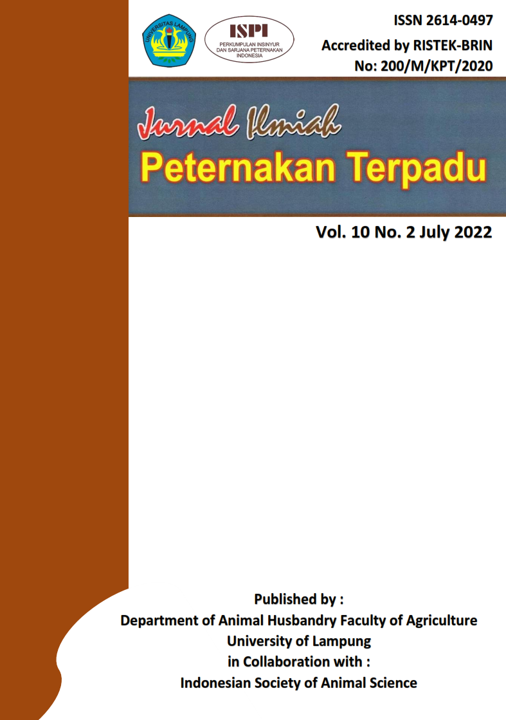Effect of Egg White Addition on pH, Density, Emulsion Stability and Color of Mayonnaise
DOI:
https://doi.org/10.23960/jipt.v10i2.p144-154 Abstract View: 3550
Abstract View: 3550
Keywords:
Egg whites, Mayonnaise, Emulsion StabilityAbstract
Mayonnaise can be made with the addition of egg whites, therefore it can increase the use of white egg. This work aimed to study the effect of egg whites addition on pH, density, emulsion stability and the color of mayonnaise. The research design using Completely Randomized Design (CRD) single factor, namely the level addition of egg white which consists of 4 treatments (0%, 5%, 10%, and 15%) with 3 replication. Parameters investigated were pH, density, emulsion stability and the color (brightness (L*), redness color (a*) and yellowness color (b*)) of mayonnaise. The data obtained was analyzed with ANOVA at α = 5%, and If there was a significant difference, the continue with the Dunnet test. The research result showed there were significant difference (P<0,05) in egg white level addition on the pH and brightness of the mayonnaise and did not significantly affect the density, emulsion stability, reddness, and yelloness color.Downloads
References
Abu-salem, F.M., A.A. Abou. 2008. Chemical , microbiological and sensory evaluation of mayonnaise prepared from ostrich eggs. Grasas Y Aceites, 59(4): 352–360. DOI: 10.3989/gya.2008.v59.i4.529
Agustina, N., I. Thohari, D. Rosyidi. 2012. Evaluasi sifat putih telur ayam pasteurisasi ditinjau dari pH , kadar air , sifat emulsi dan daya kembang Angel Cake. Jurnal Ilmu-Ilmu Peternakan, 23(2): 6–13.
Alleoni, A.C.C. 2006. Albumen protein and functional properties of gelation and foaming. Scientia Agricola, 63(3), 291–298. DOI: 10.1590/S0103-90162006000300013
Amertaningtyas, D., Brawijaya. 2017. Sifat Fisiko-Kimia Mayonnaise dengan Berbagai Tingkat Konsentrasi Minyak Nabati dan Kuning Telur Ayam Buras. Jurnal Ilmu-Ilmu Peternakan, 21(1): 1–6.
Amin, M.H.H., A.E. Elbeltagy, M. Mustafa, A.H. Khalil. 2014. Development of low fat mayonnaise containing different types and levels of hydrocolloid gum Sensory optimization of low fat mayonnaise (different oils and gums). Journal of Agroalimentary Processes and Technologies, 20(1): 54–63.
Ariizumi, M., M. Kubo, A. Handa, T. Hayakawa, K. Matsumiya, Y. Matsumura. 2017. Influence of processing factors on the stability of model mayonnaise with whole egg during long- term storage. Bioscience, Biotechnology, and Biochemistry, 8451, 1–9. DOI: 10.1080/09168451.2017.1281725
Bagnulo, J.D. 2006. Carbohydrate. In Scientific Evidence for Musculoskeletal, Bariatric, and Sports Nutrition. DOI: 10.5005/jp/books/12611_4
Budhikarjono, K. 2005. Bahan Baku Sabun Melalui Proses Pemucatan. Hal. 54–59.
Budiman, C., Rukmiasih. 2007. Karakteristik Putih Telur Itik Tegal. Seminar Nasional Teknologi Peternakan dan Veteriner, 21-22 Agustus 2007. Puslitbang Peternakan. Bogor. Hal. 636–642.
Muzaifa, M. 2013. Perubahan Karakteristik Fisik Belimbing Wuluh selama Fermentasi Asam Sunti. Jurnal Teknologi dan Industri Pertanian Indonesia, 5(2): 7–11. DOI: 10.17969/jtipi.v5i2.1002
Charrondiere, U. R., D. Haytowitz, B. Stadlmayr. 2012. FAO/INFOODS Databases. Density Database, 1–24.
Depree, J.A., G.P. Savage. 2001. Physical and flavour stability of mayonnaise. Trends in Food Science & Technology, 12(5–6): 157–163.
Documents, F.P. 1990. United States Patent (19) U .S . Patent. 19.
Ekawati, E.R., W. Darmanto. 2019. Lemon (Citrus limon) Juice Has Antibacterial Potential against Diarrhea-Causing Pathogen. IOP Conference Series: Earth and Environmental Science, 217(1). DOI: 10.1088/1755-1315/217/1/012023
Rusalim, M.M., Tamrin, Gusnawaty. 2017. Analisis sifat fisik mayonnaise berbahan dasar putih telur dan kuning telur dengan penambahan berbagai jenis minyak nabati. Journal Sains dan Teknologi Pangan, 2(5): 770–778. DOI: 10.33772/jstp.v2i5.3737
Karas, R, M. Skvarca, Bozidar Zlender. 2002. Sensory Quality of Standard and Light Mayonnaise during Storage. Food Technol. Biotechnol. 40(2): 119–127.
Kartikasari, L.R., B.S. Hertanto, A.M.P. Nuhriawangsa. 2019. Evaluasi Kualitas Organoleptik Mayonnaise Berbahan Dasar Kuning Telur yang Mendapatkan Suplementasi Tepung Purslane (Portulaca oleracea). Jurnal Ilmu Produksi Dan Teknologi Hasil Peternakan, 7(2): 81–87. DOI: 10.29244/jipthp.7.2.81-87
McClements, D.J., S.M. Jafari. 2018. Improving emulsion formation, stability and performance using mixed emulsifiers: A review. Advances in Colloid and Interface Science, 251: 55–79. DOI: 10.1016/j.cis.2017.12.001
Mirzanajafi-Zanjani, M., M. Yousefi, A. Ehsani. 2019. Challenges and approaches for production of a healthy and functional mayonnaise sauce. Food Science and Nutrition, 7(8), 2471–2484. DOI: 10.1002/fsn3.1132
Prasetya, D.A., H. Evanuarini. 2019. Kualitas Mayonnaise Menggunakan Sari Belimbing Wuluh (Averrhoa Bilimbi L.) Sebagai Pengasam Ditinjau dari Kestabilan Emulsi, Droplet Emulsi dan Warna. Jurnal Ilmu dan Teknologi hasil Ternak, 14(1): 20–29.
Rukke, E., R.B. Schüller. 2019. Rheological properties of different types of mayonnaise. Annual Transaction of the Nordic Rheology Society, 27: 165–171.
U.S. Department of Agriculture. 2017. Commercial Item Description - Mayonnaise, Salad Dressing, and Tartar Sauce A-A-20140E. 1–12. https://www.ams.usda.gov/sites/default/files/media/CID Mayonnaise%2C Salad Dressing%2C and Tartar Sauce.pdf
Yamamoto, Y., M. Araki. 2014. Effects of lecithin addition in oil or water phase on the stability of emulsions made with whey proteins. Bioscience, Biotechnology and Biochemistry, 61(11): 1791–1795. DOI: 10.1271/bbb.61.1791
Downloads
Published
How to Cite
Issue
Section
License

Jurnal Ilmiah Peternakan Terpadu(JIPT) is licensed under a Creative Commons Attribution 4.0 International License.
Authors who publish with this journal agree to the following terms:
- Authors retain copyright and grant the journal right of first publication with the work simultaneously licensed under a Creative Commons Attribution License that allows others to share the work with an acknowledgement of the work's authorship and initial publication in this journal.
- Authors are able to enter into separate, additional contractual arrangements for the non-exclusive distribution of the journal's published version of the work (e.g., post it to an institutional repository or publish it in a book), with an acknowledgement of its initial publication in this journal.
- Authors are permitted and encouraged to post their work online (e.g., in institutional repositories or on their website) prior to and during the submission process, as it can lead to productive exchanges, as well as earlier and greater citation of published work (See The Effect of Open Access).





















